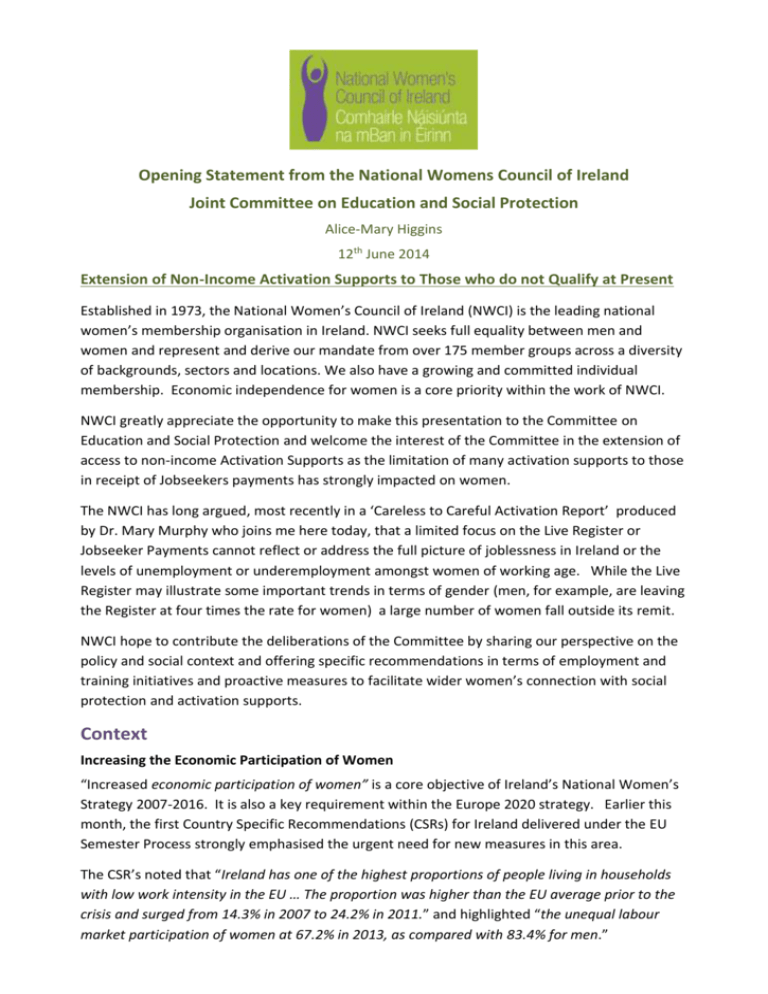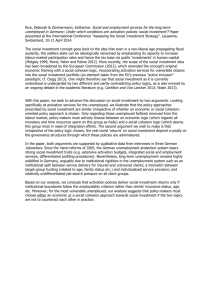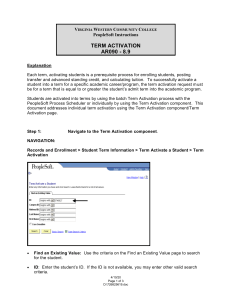12 June 2014 Presentation from National Womens Council
advertisement

Opening Statement from the National Womens Council of Ireland Joint Committee on Education and Social Protection Alice-Mary Higgins 12th June 2014 Extension of Non-Income Activation Supports to Those who do not Qualify at Present Established in 1973, the National Women’s Council of Ireland (NWCI) is the leading national women’s membership organisation in Ireland. NWCI seeks full equality between men and women and represent and derive our mandate from over 175 member groups across a diversity of backgrounds, sectors and locations. We also have a growing and committed individual membership. Economic independence for women is a core priority within the work of NWCI. NWCI greatly appreciate the opportunity to make this presentation to the Committee on Education and Social Protection and welcome the interest of the Committee in the extension of access to non-income Activation Supports as the limitation of many activation supports to those in receipt of Jobseekers payments has strongly impacted on women. The NWCI has long argued, most recently in a ‘Careless to Careful Activation Report’ produced by Dr. Mary Murphy who joins me here today, that a limited focus on the Live Register or Jobseeker Payments cannot reflect or address the full picture of joblessness in Ireland or the levels of unemployment or underemployment amongst women of working age. While the Live Register may illustrate some important trends in terms of gender (men, for example, are leaving the Register at four times the rate for women) a large number of women fall outside its remit. NWCI hope to contribute the deliberations of the Committee by sharing our perspective on the policy and social context and offering specific recommendations in terms of employment and training initiatives and proactive measures to facilitate wider women’s connection with social protection and activation supports. Context Increasing the Economic Participation of Women “Increased economic participation of women” is a core objective of Ireland’s National Women’s Strategy 2007-2016. It is also a key requirement within the Europe 2020 strategy. Earlier this month, the first Country Specific Recommendations (CSRs) for Ireland delivered under the EU Semester Process strongly emphasised the urgent need for new measures in this area. The CSR’s noted that “Ireland has one of the highest proportions of people living in households with low work intensity in the EU … The proportion was higher than the EU average prior to the crisis and surged from 14.3% in 2007 to 24.2% in 2011.” and highlighted “the unequal labour market participation of women at 67.2% in 2013, as compared with 83.4% for men.” The ESRI have actually noted a reversal in the long-term rise in female participation rates during the recent years. It is also interesting that participation rates fall to 55% for married women. Childcare is a key factor in the low participation of women as clearly seen in CSO figures on labour market participation for men and women age 20 -44. In 2011, participation for men and women without children was almost equal at 84.8% and 85.7 %. However, with a youngest child under 3, women’s participation rate plummets to 57% and after the youngest child has reached 6 or over, participation still remains at only 58%. Childcare remains an issue that must be urgently tackled if Ireland’s targets for women’s participation are ever to be achieved. For this reason, NWCI would strongly recommend inclusion of childcare, including after school care, as an essential non-income activation support within the Committee’s proposals. Not only are women disproportionately affected by the challenges of balancing employment and care, many face significant obstacles to re-entering the labour market after any sustained period of absence, finding most avenues of activation closed to them. I am aware that INOU will touch on specific challenges faced by those excluded from activation supports through means testing or due to their partner’s employment. This is an issue which affects many women and contributes greatly to household insecurity as given the increasingly precarious nature of much employment; households may slip into joblessness with little notice. Extension of the activation supports discussed here today could help build household resilience. Increased voluntary access to certain activation supports would also be welcomed by many women on disability payments and the opportunity to seek out training or career planning supports could prove very valuable for some recipients of One Parent Family Allowance in terms of facilitating future job-readiness. Young women’s access to activation is also an Area in which NWCI is currently undertaking significant research and these are all areas I would be happy to return to in questions. However, in the limited time available today, NWCI would like to focus particularly on currently jobless households and the situation of Qualified Adults in particular. Qualified Adults The category of ‘Qualified Adults’ reflects our Social Protection system’s origins in a model based on one (usually male) breadwinner and financial decision maker. Under this arrangement, recipients of social welfare payment such as a Contributory Pension or Jobseekers Allowance may apply for an increase to their personal payment in respect of a spouse or partner - a ‘Qualified Adult’ (formerly known as Adult Dependant). There is a strong gendered dimension to this arrangement – over 90% of Qualified Adults are women – and, although in certain circumstances direct payment to the QA themselves may be facilitated, it can contribute to an imbalance in the power and decision-making dynamics within households - including the decision to return to work. These concerns were highlighted by women themselves in recent research by Creegan and Murphy at NUIMaynooth. “Sure I can hardly go to the shops without him wanting to know where I am, never mind working” “I couldn’t have worked full time cos if I had...he would have lost his labour” Creegan and Murphy, 2013, NUI Maynooth Because such women are not in the system in their own right, very little is known about them. NWCI have long called for comprehensive data collection and disaggregation around on Qualified Adults. NWCI also strongly support policy recommendations around administrative individualisation as a step towards an individualised social welfare system, as made in Department of Social Protection’s 2006 report. Such administrative individualisation could, for example, be introduced for all new coupled claimants and I know that Dr. Murphy and others have practical proposals as to how such a change might be implemented. Constructive non-income activation proposals are certainly a positive and practical step in the right direction. Currently Qualified Adults have little or no access to activation support. In fact one of the very few schemes which had been available was recently terminated. The ‘Spousal Swap’ allowed an individual entitled to participation in a CE scheme or Back to Education initiative to transfer that opportunity to their spouse. While this was a flawed scheme in that decisions rested with the person, usually male, already in the system, it did facilitate negotiated shifts in breadwinner and carer roles within a number of families. Its termination closed off an avenue to activation for many women and the principle that either adult in a jobless household should be able to participate in certain income activation schemes should be restored. While some Qualified Adults of working age may have partners in receipt of pensions, I will focus on Qualified Adults with partners are in receipt of Jobseekers Payments as activation is particularly important within jobless households experiencing high rates of poverty. In August 2012, over 95,045 Qualified Adults were recognised within Jobseeker Payments. The ‘Careless to Careful Activation’ report makes note of a 2010 investigation which found that Jobseeker claimants with a Qualified Adult had only 67% of the average rate of claim closure. The report also found that over 50% of Qualified Adults make use of a small income disregard. This suggests that many Qualified Adults may already be making some limited contact with the labour market and more might be open to the possibility. In many cases the Qualified Adults may actually have more to bring to or gain from an activation or training opportunity. It is also important that the decision and opportunity to access non-income activation supports be placed in the hands of Qualified Adults themselves. The opening up certain opportunities and supports to both partners could have a very positive impact on reducing the number of jobless households. This approach also recognises and supports that household dynamics can change and breadwinner or caring responsibilities may shift. It is, however, important not to assume that caring can easily be shared. Research by Creegan and others highlights a range of reasons, from depression to traditionalist views, why women may not feel able to transfer care to a partner. Again, access to public childcare is crucial and it is also important to recognise that many Qualified Adults who are very interested in entering the workforce may not be available for full time activation. The Jobseekers Transitional Payment as introduced for Lone Parents represents an important recognition of part time availability and could provide a suitable model for Qualified Adults with children aged 0-14. Pension Security as Activation Incentive Difficulties in entering or re-entering the workforce do not just affect women in the immediate term; they can also store up economic insecurity for the future. The legacy of inequalities such as the Marriage Bar is still felt in the reduced pensions of many older women. Only 16% of those receiving a full contributory pension are women. Proactive measures are necessary to prevent long-term gendered income inequality for a new generation and a gender impact assessment should be conducted into all changes contribution thresholds, particularly the rising number of previous contributions required before being permitted to make voluntary pension contributions. This should not be set at a level that makes it impossible for women entering the workforce after an absence to catch up but should instead incentivise employment. Homemakers Disregard is also important in relation to Pensions Security and the transition to Homemakers Credit for new and future claimants is long overdue. Delivering on that commitment would send a signal to all those working in the home that their work is not just ‘disregarded’ it is recognised, credited and connected to wider society. Homemakers Credit could extend beyond Pension calculations to act as an active link to activation support. Indeed, even those availing of the current Homemakers Disregard could be offered access to targeted activation supports at specific intervals. Recommendations Extension of Non-Income Activation Supports to Qualified Adults Choice It is essential that engagement with non-income activation measures should be voluntary and that decision making be in the hands of qualified adults themselves. Even with access to childcare, full time activation might not prove possible or appropriate for many qualified adults, and there may also be constraints around available hours for courses or training. The Jobseekers Transitional Payment as rolled out for Lone Parents could act as a model for Qualified Adults with children under 14. Quality part-time activation opportunities should be developed and facilitated and training made available at flexible times. It is also important that individuals are presented with a range of options. There is some danger of pigeonholing, for example, NWCI have heard cases of mothers seeking to re-enter the Labour market being pressed towards childcare. Career planning and other activation supports should act as an opportunity to challenge rather than reinforce gender bias. Individualisation It is important that access to activation opportunities should be placed in the hands of individuals themselves rather than routed through their partners. Administrative Individualisation could initially be rolled out in relation to the activation measures discussed here today and also in relation to new claimants. A number of practical proposals have been put forward around how this might be introduced. Education Both the “Careless to Careful Activation” report and Creegan and Murphy's research on Qualified Adults emphasise that an ‘Education First’ approach can often be most appropriate. Access to a range of educational and training options, including literacy support if required, should be central to the proposed non-income activation supports. This would also fit well with the “seamless FET referrals system between INTREO offices and Education and Training Boards “ called for within the European CSR’s. Childcare Access to appropriate childcare, including quality afterschool care, is absolutely central to activation. Europe has, through the CSR’s, also called on the Irish Government to “Facilitate female labour market participation by improving access to more affordable and full-time childcare, particularly for low income families.” The lack of affordable and accessible childcare is a direct and pressing obstacle to activation and the fight against poverty. Training for Caseworkers It is important that those working with Qualified Adults should have a strong understanding of the issues, concerns, priorities and dynamics which they might be juggling. Personalised support is important in drawing individuals closer to activation and it is important that case workers are themselves supported by appropriate training – including gender-equality training. Four Further Measures to Support Activation and Participation of Qualified Adults Comprehensive Data Collection There is a pressing need for comprehensive data collection and disaggregation in relation to Qualified Adults. Introduction of Homemakers Credit Transition from Homemakers Disregard to Homemaker’s Credit is long overdue and should be pressed forward as a matter of principle and practice. This would send an important signal of inclusion and recognition to many Qualified Adults and others who work within the home. Gender Impact Assessment of Contributory Pension Thresholds A full Gender Impact Assessment should be conducted in relation to the changes to Contributory Pension thresholds and Voluntary Pension Contribution requirements in particular to ensure such thresholds do not act as discouragement rather than incentive to activation. Clarity around Secondary Supports For many Qualified Adults, fear of negatively impacting household security or losing secondary supports such as rent allowance or medical cards can act as a serious disincentive to seeking activation. A number of proposals have been put forward in order to help address this issue.








